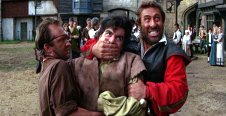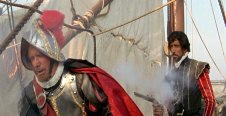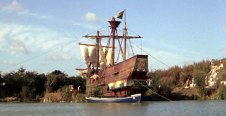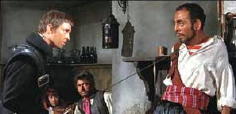THE PIRATES OF BLOOD RIVER. Hammer Films, 1962. Kerwin Mathews, Christopher Lee, Andrew Keir, Glenn Corbett, Marla Landi, Michael Ripper, Peter Arne, Oliver Reed, Marie Devereux. Screenwriters: John Hunter & John Gilling, based on a story by Jimmy Sangster. Director: John Gilling.
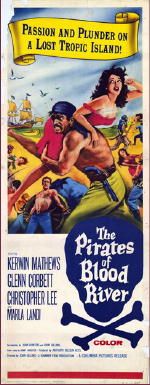
Hammer is known mostly for their horror films, of course, but over the course of the years, they did many other kinds of movies, including noir — I have several on tap to watch, and you’ll see them reviewed here soon enough, I hope — and action-adventure films, such as this one. I even had to create a new category for it, as I’m sure you’ve already have noted.
There’s no “crime” involved in pirate films, per se, except of course, piracy is a crime, and a rather glamorous one at that, movie style. Another small crime of sorts is that this is a pirate film without any boats in it, except stock footage at the beginning and the end, and hardly any water.
Blame this on small, tight budgets that the production people at Hammer had to work under, but worked wonders, they did. There are basically only four sets: the exterior of the tropical village on an island where a group of 17th century Huguenots have settled, fleeing religious persecution; the interior of their primary meeting place; a small jungle surrounding the compound, complete with one river leading to the sea; and a gravel pit doing double duty as a site for a penal colony.
And in spite of financial considerations, the movie is beautifully photographed in color, and populated as if with a cast of thousands, although in reality there may have been perhaps no more than 40 or 50 involved.
Where this island actually is is not explicitly stated, although you (the viewer) are supposed to believe that it is somewhere in the Caribbean and one that has not been discovered by anyone else. Let me get back to river, though, for a minute. Whenever it’s convenient for plot line purposes, the river is filled with hungry, ferocious piranha fish. Piranha fish and quicksand, that’s what I remember of jungle epics when I was a kid. I thought there was going to be quicksand in one scene in this movie, but apparently I was wrong. Too bad. They missed one there.

On to the story line. If there’s a moral to the story, it’s that groups fleeing religious persecution quickly revert to the tactics of their enemies, and quickly become religious zealots themselves. Jonathon Standing (Kerwin Matthews) is the son of one of the village’s board of selectmen (you might say), but that does him no good when he’s convicted of adultery and sentenced to hard labor at the aforementioned penal colony.
From which he eventually escapes, only to land in the hands of Captain LaRoche (Christopher Lee) and his men. Here, taken from the audio commentary for the film, is author Jimmy Sangster‘s original description of the man:
“A strange and fascinating creature, but the fascination is evil. At first glance, he might be called handsome, with his bone structure good. It’s the face of a man without a heart. He has wit and intelligence, and even a sense of humor — but his heart is nothing. The way he moves is so elegant that we may forget he’s a cripple; his hand held close to his body and his hand an upturned claw.”

Sangster, whose voice is one of those we hear, admits that he had Lee in mind for the part from the very beginning. Dressed all in black, with a patch over his left eye, Lee is one of those actors who commands the the viewer’s attention film from the moment we very most see him.
Another moral of the story. Don’t make deals with pirates. They don’t keep their end of the bargain. Never have, never will. I’ve known that ever since I was eight years old. Too bad that Jonathan Standing doesn’t.
The plot could have about as easily served for a good old-fashioned western melodrama, and I shall refrain from saying very much more about it. (Did Hammer Films ever make westerns? Probably not, but if you were to say yes, how surprised would I be? Not very much at all.)
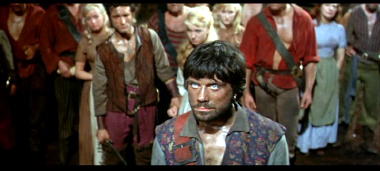
But I do want to mention one highlight of the film for me — a blindfolded swordfight to the death between two of the pirates, played by Peter Arne and Oliver Reed (the latter, as intense as usual, seen above). Whether choreographed or ad lib, it’s completely over the top, and it was worth the price of admission to me right then and there. (Surprisingly enough, the commentators stop talking to watch, but they say nothing as to how it came to be done.)
I’d also like to point out a job well done by Michael Ripper, who plays a henchman named Hench (a nice touch). Ripper usually played bartenders, innkeepers, coachmen and grave robbers in Hammer films. This time it was a much larger part, worthy of his talents, and more — he looks as though he’s enjoying himself immensely.
But is the movie worthy of your time? I enjoyed it, and if you’ve read this far, you very well may too. Vince Keenan tells me that the second movie on this disk, The Devil-Ship Pirates, also with Christopher Lee, is the better of the two. I won’t dispute that, yet. As soon as I feel like watching another pirate movie, I know exactly which one it will be.


